
37 Results

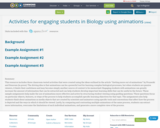
This resource includes three classroom-tested activities that were created using the ideas outlined in the article “Getting more out of animations” by Pruneski and Donovan (in press). The driving idea is that animations can be a powerful tool for learning complex biological processes, but when students are passive viewers, it limits their usefulness and may become simply another source of content to be memorized. Engaging students with animations can greatly increase the amount of information that can be extracted and can help students develop important learning skills that can be useful in the future.
These sample assignments help make the use of animations more effective and active by structuring student viewing using guiding questions. These questions focus on particular objects, features, or steps of the process to help students accomplish specific learning objectives for that topic. The assignments also help students think about animations as media objects that are created by scientists and animators using specific tools and conventions that affect how the process is depicted and the ways in which it should be viewed. Lastly, by comparing and contrasting multiple animations of the same process, students can extract more information, overcome the limitations of each individual animations, and generate a more complete view of the process.
- Subject:
- Life Science
- Material Type:
- Activity/Lab
- Homework/Assignment
- Date Added:
- 06/18/2016

This class analyzes complex biological processes from the molecular, cellular, extracellular, and organ levels of hierarchy. Emphasis is placed on the basic biochemical and biophysical principles that govern these processes. Examples of processes to be studied include chemotaxis, the fixation of nitrogen into organic biological molecules, growth factor and hormone mediated signaling cascades, and signaling cascades leading to cell death in response to DNA damage. In each case, the availability of a resource, or the presence of a stimulus, results in some biochemical pathways being turned on while others are turned off. The course examines the dynamic aspects of these processes and details how biochemical mechanistic themes impinge on molecular/cellular/tissue/organ-level functions. Chemical and quantitative views of the interplay of multiple pathways as biological networks are emphasized. Student work culminates in the preparation of a unique grant application in an area of biological networks.
- Subject:
- Applied Science
- Biology
- Engineering
- Life Science
- Physical Science
- Material Type:
- Full Course
- Provider:
- MIT
- Provider Set:
- MIT OpenCourseWare
- Author:
- Essigmann, John
- Sasisekharan, Ram
- Date Added:
- 09/01/2004
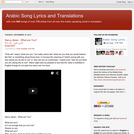
This blog offers translations of Arabic songs into English. Arabic transcriptions of the song lyrics are also provided, as are the transliterated lyrics. Where possible, the song has been added to the website as well so that users can listen to the song as well as read along. Users can request new songs to be translated, submit their own translations, and leave comments. Users can also search the site or click on a singer's name to be given a list of their songs that have been translated on the site.
- Subject:
- Arts and Humanities
- Languages
- Material Type:
- Reading
- Provider:
- arabicmusictranslation
- Date Added:
- 10/14/2013

Students act as if they are biological engineers following the steps of the engineering design process to design and create protein models to replace the defective proteins in a child’s body. Jumping off from a basic understanding of DNA and its transcription and translation processes, students learn about the many different proteins types and what happens if protein mutations occur. Then they focus on structural, transport and defense proteins during three challenges posed by the R&D; bio-engineering hypothetical scenario. Using common classroom supplies such as paper, tape and craft sticks, student pairs design, sketch, build, test and improve their own protein models to meet specific functional requirements: to strengthen bones (collagen), to capture oxygen molecules (hemoglobin) and to capture bacteria (antibody). By designing and testing physical models to accomplish certain functional requirements, students come to understand the relationship between protein structure and function. They graph and analyze the class data, then share and compare results across all teams to determine which models were the most successful. Includes a quiz, three worksheets and a reference sheet.
- Subject:
- Biology
- Life Science
- Mathematics
- Measurement and Data
- Material Type:
- Activity/Lab
- Provider:
- TeachEngineering
- Provider Set:
- Activities
- Author:
- Beth Podoll
- Lauren Sako
- Date Added:
- 06/07/2018

This is to study transcription.
- Subject:
- Life Science
- Material Type:
- Lesson
- Date Added:
- 01/09/2017

Biology is designed for multi-semester biology courses for science majors. It is grounded on an evolutionary basis and includes exciting features that highlight careers in the biological sciences and everyday applications of the concepts at hand. To meet the needs of today’s instructors and students, some content has been strategically condensed while maintaining the overall scope and coverage of traditional texts for this course. Instructors can customize the book, adapting it to the approach that works best in their classroom. Biology also includes an innovative art program that incorporates critical thinking and clicker questions to help students understand—and apply—key concepts.
- Subject:
- Biology
- Life Science
- Material Type:
- Full Course
- Provider:
- Rice University
- Provider Set:
- OpenStax College
- Date Added:
- 08/22/2012

- Subject:
- Biology
- Life Science
- Material Type:
- Unit of Study
- Provider:
- Rice University
- Provider Set:
- OpenStax College
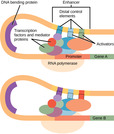
By the end of this section, you will be able to:Discuss the role of transcription factors in gene regulationExplain how enhancers and repressors regulate gene expression
- Subject:
- Applied Science
- Biology
- Life Science
- Material Type:
- Module
- Date Added:
- 07/10/2017

- Subject:
- Applied Science
- Biology
- Life Science
- Material Type:
- Module
- Date Added:
- 07/10/2017

- Subject:
- Biology
- Life Science
- Material Type:
- Unit of Study
- Provider:
- Rice University
- Provider Set:
- OpenStax College

- Subject:
- Applied Science
- Biology
- Life Science
- Material Type:
- Module
- Date Added:
- 07/10/2017

By the end of this section, you will be able to:Describe the structure of nucleic acids and define the two types of nucleic acidsExplain the structure and role of DNAExplain the structure and roles of RNA
- Subject:
- Applied Science
- Biology
- Life Science
- Material Type:
- Module
- Date Added:
- 07/10/2017

This course focuses on feedback control mechanisms that living organisms implement at the molecular level to execute their functions, with emphasis on techniques to design novel systems with prescribed behaviors. Students will learn how biological functions can be understood and designed using notions from feedback control.
- Subject:
- Applied Science
- Biology
- Engineering
- Life Science
- Physical Science
- Material Type:
- Full Course
- Provider:
- MIT
- Provider Set:
- MIT OpenCourseWare
- Author:
- Del Vecchio, Domitilla
- Date Added:
- 02/01/2015
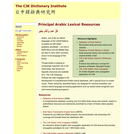
The CJK Dictionary Institute was originally established for Chinese, Japanese, and Korean (CJK) resources, but has been expanded in recent years to other languages, including Arabic. The many Arabic resources available through the CJK Dictionary Institute include databases of proper nouns, transliteration programs, dictionaries, databases, articles related to transcription and translation issues, and more. The institute also provides software developers with dictionary data as well as consulting services.
- Subject:
- Arts and Humanities
- Languages
- Material Type:
- Reading
- Provider:
- The CJK Dictionary Institute
- Date Added:
- 10/14/2013

The goal of this course is to teach both the fundamentals of nuclear cell biology as well as the methodological and experimental approaches upon which they are based. Lectures and class discussions will cover the background and fundamental findings in a particular area of nuclear cell biology. The assigned readings will provide concrete examples of the experimental approaches and logic used to establish these findings. Some examples of topics include genome and systems biology, transcription, and gene expression.
- Subject:
- Biology
- Life Science
- Physical Science
- Material Type:
- Full Course
- Provider:
- MIT
- Provider Set:
- MIT OpenCourseWare
- Author:
- Sharp, Phillip
- Young, Richard
- Date Added:
- 02/01/2010

This outline was created for use with my online Fundamentals of Biology course at West Hills College, Lemoore, CA. It is intended to accompany Concepts of Biology by Open Stax.
- Subject:
- Biology
- Life Science
- Material Type:
- Lecture Notes
- Date Added:
- 12/24/2018

The course focuses on casting contemporary problems in systems biology and functional genomics in computational terms and providing appropriate tools and methods to solve them. Topics include genome structure and function, transcriptional regulation, and stem cell biology in particular; measurement technologies such as microarrays (expression, protein-DNA interactions, chromatin structure); statistical data analysis, predictive and causal inference, and experiment design. The emphasis is on coupling problem structures (biological questions) with appropriate computational approaches.
- Subject:
- Applied Science
- Biology
- Health, Medicine and Nursing
- Life Science
- Physical Science
- Material Type:
- Full Course
- Provider:
- MIT
- Provider Set:
- MIT OpenCourseWare
- Author:
- Gifford, David
- Jaakkola, Tommi
- Date Added:
- 02/01/2005
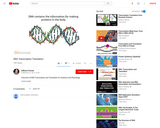
Short video covering DNA transcription/translation for Anatomy and Physiology.
- Subject:
- Anatomy/Physiology
- Biology
- Life Science
- Material Type:
- Activity/Lab
- Author:
- Dr. Bruce Forciea
- Date Added:
- 04/02/2018

Since the discovery of the structure of the DNA double helix in 1953 by Watson and Crick, the information on detailed molecular structures of DNA and RNA, namely, the foundation of genetic material, has expanded rapidly. This discovery is the beginning of the “Big Bang” of molecular biology and biotechnology. In this seminar, students discuss, from a historical perspective and current developments, the importance of pursuing the detailed structural basis of genetic materials.
- Subject:
- Biology
- Genetics
- Life Science
- Physical Science
- Material Type:
- Full Course
- Provider:
- MIT
- Provider Set:
- MIT OpenCourseWare
- Author:
- Zhang, Shuguang
- Date Added:
- 09/01/2005